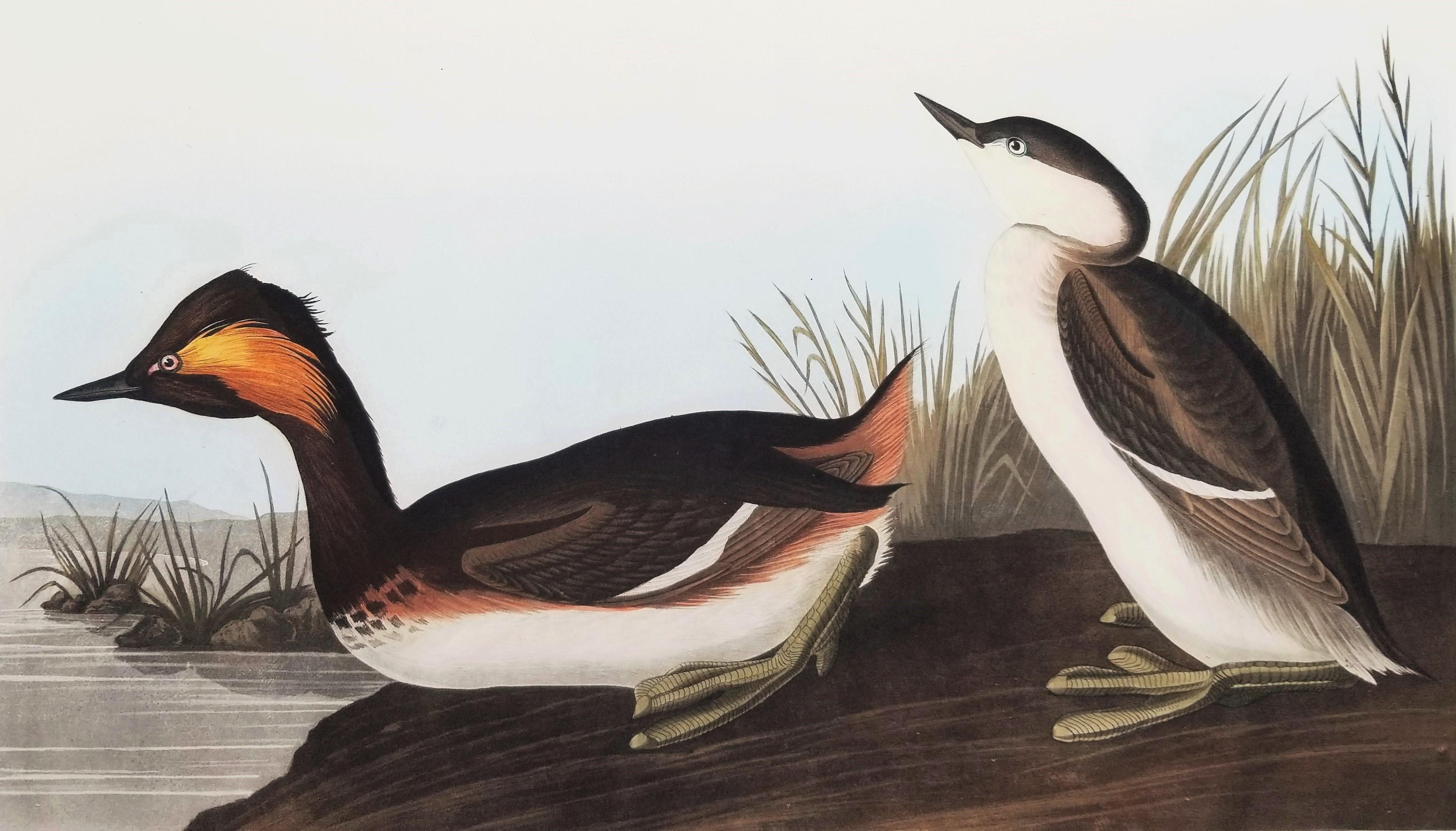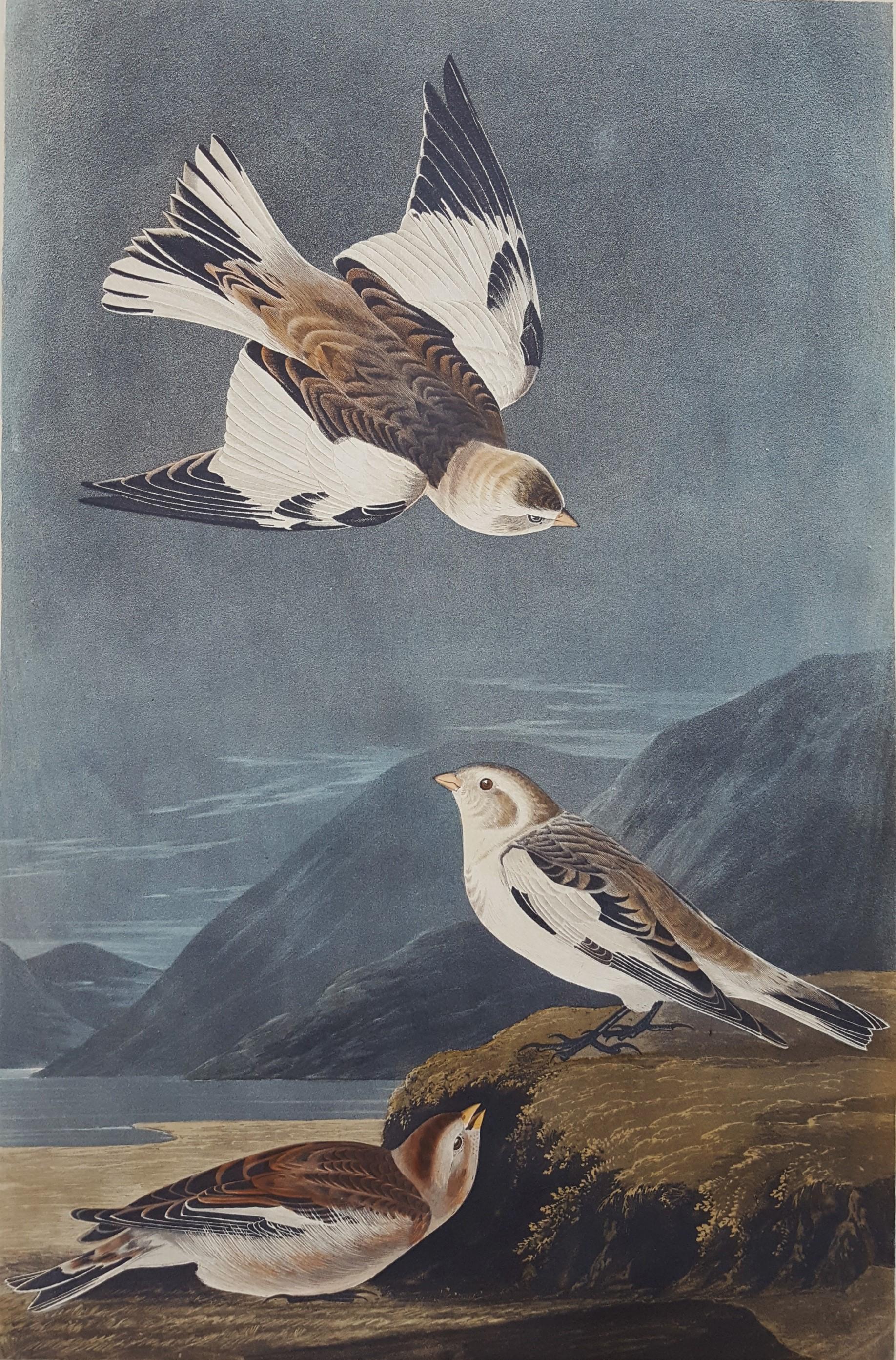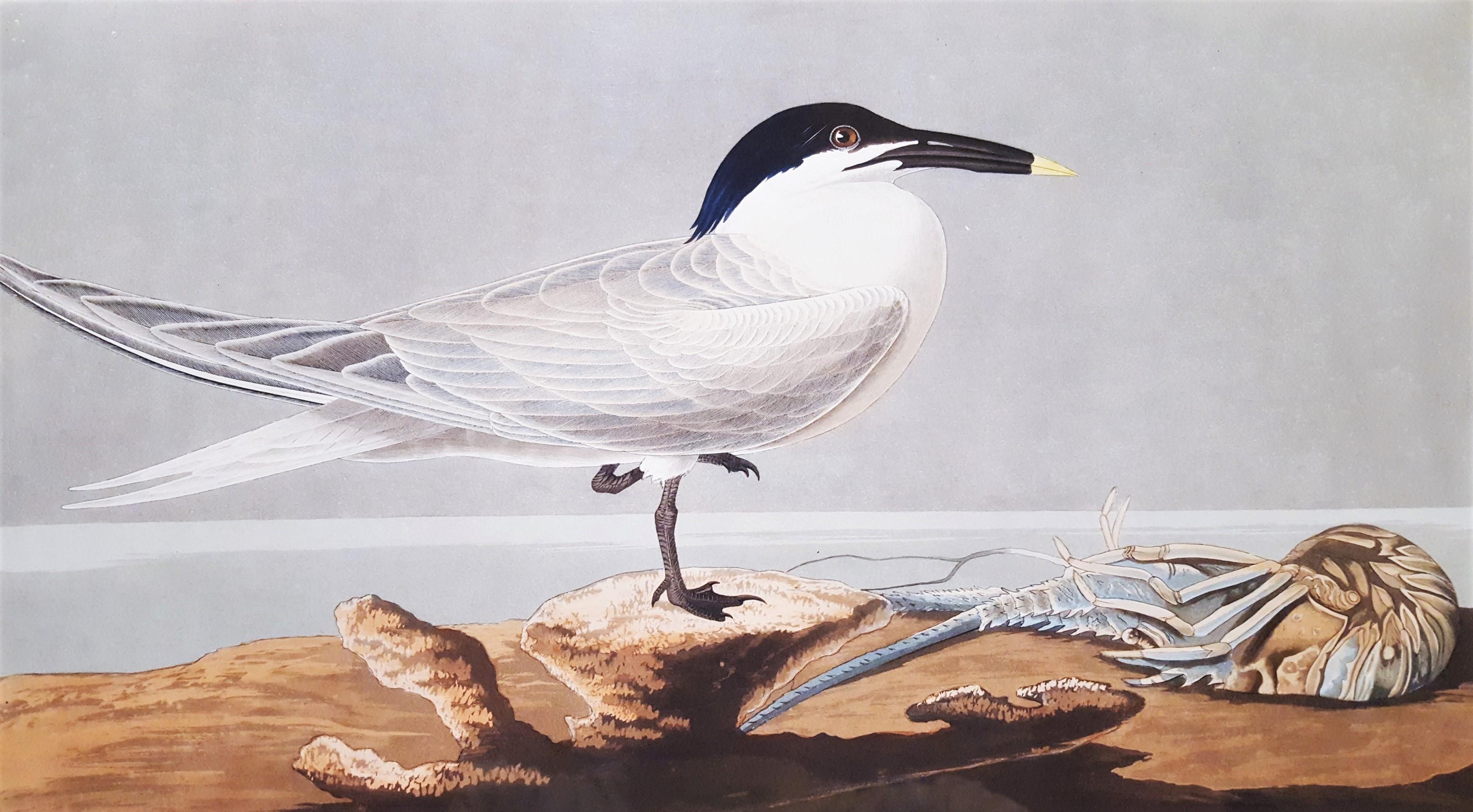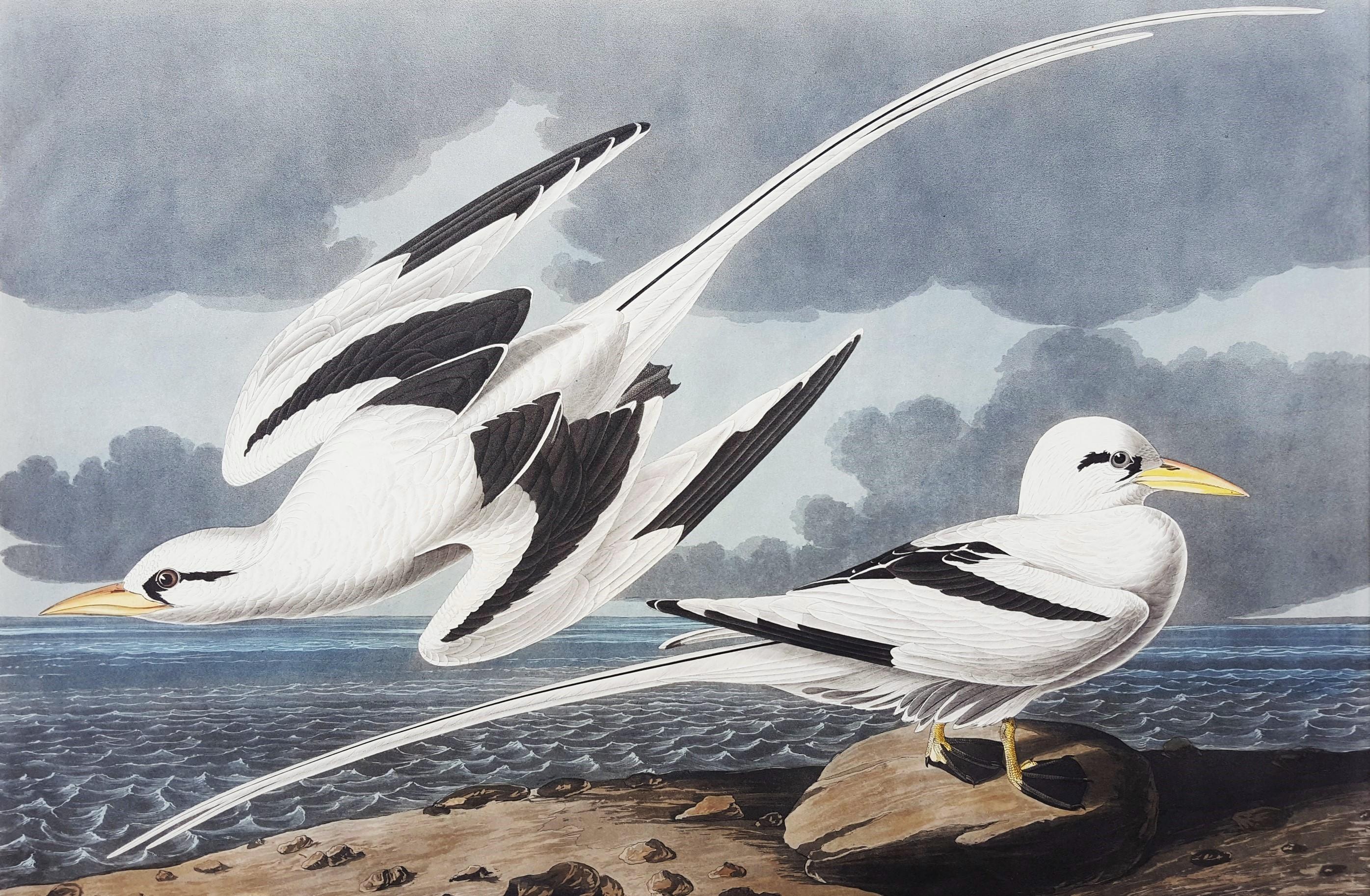Items Similar to Red Phalarope /// Ornithology John James Audubon Bird Animal Landscape Havell
Want more images or videos?
Request additional images or videos from the seller
1 of 24
John James AudubonRed Phalarope /// Ornithology John James Audubon Bird Animal Landscape Havell1835
1835
About the Item
Artist: John James Audubon (American, 1785-1851)
Title: "Red Phalarope" (Plate CCLV - 255; part No. 51)
Portfolio: The Birds of America, Havell Edition
Year: 1835
Medium: Original Hand-Colored Engraving with Aquatint on double-elephant folio, J. Whatman paper
Limited edition: approx. 180
Printer: Robert Havell Jr., London, UK
Publisher: John James Audubon, London, UK
Sheet size: 22.25" x 29"
Platemark size: 15.75" x 22.63"
Image size: 13.25" x 20.75"
Condition: One small tear upper left in margin which has been professionally repaired. In excellent condition with clean paper and strong colors
Rare
Notes:
Comes from Audubon's monumental book volume "The Birds of America", (Havell Edition, 1827-1838), which consists of 435 hand-colored, life-size prints, made from engraved plates, with each sheet originally measuring around 39" x 26". Engraved, printed, and hand-colored by English artist Robert Havell Jr. (1793-1878). "J. Whatman 1834" watermark upper left.
Based on a composition painted in London in 1835. Edward Dwight states that "Audubon encountered this bird only twice - in Louisville, Kentucky, in late October, 1808, and years later, in September, 1831, aboard ship about sixty miles off Nantucket Island". He adds "In most species of birds the male is brightly colored and takes the active role in courtship. Of phalaropes, the converse is true. Never having observed its peculiar breeding habits, Audubon mistakenly identified the dull grey bird at center as a female; actually it is a male, flanked by colorful female phalaropes."
The red phalarope is about 21 cm (8.3 in) in length, with lobed toes and a straight bill, somewhat thicker than that of red-necked phalarope. The breeding female is predominantly dark brown and black above, with red underparts and white cheek patches. The bill is yellow, tipped black. The breeding male is a duller version of the female. Young birds are light grey and brown above, with buff underparts and a dark patch through the eye. In winter, the plumage is essentially grey above and white below, but the black eyepatch is always present. The bill is black in winter. Their call is a short beek.
"The Birds of America" (Havell Edition) - In Edinburgh, the Scottish engraver W. H. Lizars began to produce the very first plates for Birds of America. However, after the completion of only ten plates, Lizars' colorists went on strike, and Audubon was forced to continue his pursuit of an engraver. Audubon's dream finally found fruition with Robert Havell, a renowned London engraver. The portfolio of Birds of America, consisting of 435 hand-colored engravings, took twelve years, from 1826 to 1838, to complete. Havell also retouched Lizars' original efforts, adding aquatint to the engraving, and on those ten plates the Havell name appears alongside that of the Scottish engraver's. There were 176 recorded subscribers to the 'Birds of America' series and it is known that a handful of extra Audubon books were produced as well. Of the approximate amount of 180 ever produced, roughly 100 have never been broken and remain in permanent public museum and institution collections. In light of that, roughly only 80 examples possibly exist on the open market in private hands today.
Biographies:
John James Audubon (April 26, 1785, Les Cayes, Saint-Domingue (later Haiti) – January 27, 1851 (aged 65) Manhattan, New York, U.S.), born Jean-Jacques Audubon, was an American ornithologist, naturalist, and painter. He was notable for his expansive studies to document all types of American birds and for his detailed illustrations that depicted the birds in their natural habitats. His major work, a color-plate book entitled The Birds of America (1827–1839), is considered one of the finest ornithological works ever completed. Audubon identified 25 new species.
Robert Havell Jr. (25 November 1793 – 11 November 1878) was the principal engraver of Audubon's Birds of America, perhaps the most significant natural history publication of all time. His aquatint engraving of all but the first ten plates of John James Audubon's Birds of America is now recognized as a significant artistic achievement in its own right and an essential component of the success of Birds of America. He and Audubon became close friends and associates during their lengthy collaboration. In 1839 Havell went to America at the invitation of Audubon, first residing in Brooklyn. He settled in Ossining on the Hudson River and later moved to Tarrytown, New York, living there from 1857 through his remaining years. Although Havell continued to work in aquatint and engraving (primarily city panoramas), he devoted most of his attention to painting the countryside of the Hudson River valley. He traveled frequently in a homemade horse-drawn trailer, sketching and taking notes and translating his sketches into larger oils. Robert Havell Jr. is considered a member of the Hudson River School of American painters. He died in 1878 and is buried in Sleepy Hollow Cemetery in Tarrytown.
- Creator:John James Audubon (1785-1851, American, French)
- Creation Year:1835
- Dimensions:Height: 22.25 in (56.52 cm)Width: 29 in (73.66 cm)Depth: 0.1 in (2.54 mm)
- Medium:
- Movement & Style:
- Period:
- Condition:
- Gallery Location:Saint Augustine, FL
- Reference Number:1stDibs: LU12124382642
About the Seller
5.0
Platinum Seller
These expertly vetted sellers are 1stDibs' most experienced sellers and are rated highest by our customers.
Established in 1978
1stDibs seller since 2015
1,217 sales on 1stDibs
Typical response time: <1 hour
- ShippingRetrieving quote...Ships From: Saint Augustine, FL
- Return PolicyA return for this item may be initiated within 3 days of delivery.
More From This SellerView All
- Eared Grebe /// John James Audubon Ornithology Havell Edition Bird Animal ArtBy John James AudubonLocated in Saint Augustine, FLArtist: John James Audubon (American, 1785-1851) Title: "Eared Grebe" (Plate CCCCIV - 404; part No. 81) Portfolio: The Birds of America, Havell Edition Year: 1838 Medium: Original Ha...Category
1830s Victorian Animal Prints
MaterialsWatercolor, Engraving, Aquatint, Intaglio
- Greenshank (View of St. Augustine & Spanish Fort East Florida) /// Bird AudubonBy John James AudubonLocated in Saint Augustine, FLArtist: John James Audubon (American, 1785-1851) Title: "Greenshank (View of St. Augustine & Spanish Fort East Florida)" (Plate CCLXIX - 269; part No. 54) Portfolio: The Birds of America, Havell Edition Year: 1835 Medium: Original Hand-Colored Engraving with Aquatint on double-elephant folio, J. Whatman paper Limited edition: approx. 180 Printer: Robert Havell Jr., London, England Publisher: John James Audubon, London, England Framing: Recently framed in an ornate black and gold moulding with fabric rag matting and gold filet Framed size: 26.25" x 31.75" Sheet size: 21.75" x 27.25" Platemark size: 15" x 20.63" Image size: 12" x 18" Condition: The sheet is laid down to board. Light toning and discoloration to sheet. The occasional pinhole or faint surface abrasion. In otherwise good condition with good colors Rare Notes: Provenance: private collection - Denver, CO. Engraved, printed, and hand-colored by English artist Robert Havell Jr. (1793-1878). Comes from Audubon's monumental book volume "The Birds of America", (Havell Edition, 1827-1838), which consists of 435 hand-colored, life-size prints, made from engraved plates, with each sheet originally measuring around 39" x 26". The would be "J. Whatman 1835" watermark is likely missing due to its trimming. The composition was probably painted in England in 1835, using a preserved specimen. Since no other than Audubon has ever claimed to have seen this European...Category
1830s Victorian Animal Prints
MaterialsWatercolor, Engraving, Aquatint, Intaglio
- Snow Bunting /// Ornithology John James Audubon Bird Animal Landscape Havell ArtBy John James AudubonLocated in Saint Augustine, FLArtist: John James Audubon (American, 1785-1851) Title: "Snow Bunting" (Plate CLXXXIX - 189; part No. 38) Portfolio: The Birds of America, Havell Edition ...Category
1830s Victorian Animal Prints
MaterialsEngraving, Aquatint, Watercolor, Intaglio, Rosewood
- Sandwich Tern (with Florida Cray Fish) (Florida Keys) /// Ornithology AudubonBy John James AudubonLocated in Saint Augustine, FLArtist: John James Audubon (American, 1785-1851) Title: "Sandwich Tern (with Florida Cray Fish) (Florida Keys)" (Plate CCLXXIX - 279; part No. 56) Portfo...Category
1830s Victorian Animal Prints
MaterialsGold Leaf
- Tropic Bird /// Ornithology John James Audubon Shorebird Ocean Beach SeascapeBy John James AudubonLocated in Saint Augustine, FLArtist: John James Audubon (American, 1785-1851) Title: "Tropic Bird" (Plate CCLXII - 262; part No. 53) Portfolio: The Birds of America, Havell Edition Year: 1835 Medium: Original Hand-Colored Engraving with Aquatint on double-elephant folio, J. Whatman paper Limited edition: approx. 180 Printer: Robert Havell Jr., London, England Publisher: John James Audubon, London, England Framing: Not framed, but matted in a handmade custom French matting Matted size: 30" x 38.75" Sheet size: 25.5" x 36" Platemark size: 20.75" x 30.25" Image size: 18.5" x 27.75" Condition: A few tiny foxmarks. In excellent condition with clean paper and strong colors Rare Notes: Provenance: private collection - New York, NY. Engraved, printed, and hand-colored by English artist Robert Havell Jr. (1793-1878). Comes from Audubon's monumental book volume "The Birds of America", (Havell Edition, 1827-1838), which consists of 435 hand-colored, life-size prints, made from engraved plates, with each sheet originally measuring around 39" x 26". "J. Whatman 1835" watermark upper right. Based on a composition painted between 1832 and 1835. Audubon sailed the entire length of Florida, around the Keys and as far as the Dry Tortugas, from which, on another occasion, "The specimens - in the plate were taken - by my kind friend Robert Day, Esq. of the United States Revenue Cutter...Category
Early 1800s Victorian Animal Prints
MaterialsIntaglio, Watercolor, Engraving, Aquatint
- Set of Four Hand-Colored Ornithological Engravings by John Latham /// Bird UKBy John LathamLocated in Saint Augustine, FLArtist: John Latham (English, 1740-1837) Title: "Kamtschatkan Thrush", "Spotted-sided Grosbeak", "Crimson-bellied Flycatcher", and "Black-headed Grosbeak" Portfolio: A General History of Birds Year: 1821-1828 (second edition) Medium: Set of Four Original Hand-Colored Engravings on watermarked wove paper Limited edition: Unknown Printer: Jacob & Johnson, Winchester, UK Publisher: John Latham, Winchester, UK Reference: Brunet III, 872; Lowndes II, page 1314; Fine Bird Books page 87; Nissen IVB 532; Zimmer page 376 Sheet size (each): approx. 11.25" x 8.88" Image size (each): approx. 4.5" x 4.5" Condition: "Kamtschatkan Thrush", "Crimson-bellied Flycatcher", and "Black-headed Grosbeak" have some light offsetting to their sheets. "Spotted-sided Grosbeak" has some minor foxmarks and some light discoloration upper left in margin. They are all otherwise in very good condition with strong colors Rare Notes: Provenance: acquired from Christie's, New York, NY, December 19, 1990. Comes from Latham's famous eleven volume portfolio "A General History of Birds" (1821-1828) (second edition), which consists of 193 hand-colored prints, made from engraved plates. "Kamtschatkan Thrush" and "Crimson-bellied Flycatcher" have an unidentified "1821" watermark lower right and upper right respectively. "Spotted-sided Grosbeak" has a "1820" watermark lower right. Biography: John Latham (27 June 1740 – 4 February 1837) was an English physician, naturalist and author. His main works were A General Synopsis of Birds (1781–1801) and General History of Birds (1821–1828). He was able to examine specimens of Australian birds...Category
1820s Victorian Animal Prints
MaterialsIntaglio, Engraving, Watercolor
You May Also Like
- Blue Jays, Aquatint Etching by Martin BarooshianBy Martin BarooshianLocated in Long Island City, NYBlue Jays Martin Barooshian, American (1929–2022) Date: circa 1981 Intaglio Etching and Aquatint, signed and numbered in pencil Edition of 175, AP 25 Image S...Category
1980s Animal Prints
MaterialsEtching, Intaglio, Aquatint
- Stanley Boxer Aquatint Intaglio Etching Elephant Herd Abstract ExpressionistBy Stanley BoxerLocated in Surfside, FLElephants. 1979 edition 2/20 Hand signed and dated Framed 24.5 X 28. Sheet 23 X 26 This is from a series of prints Boxer produced at Tyler Graphics between 1975 and 1979. Over this period, he created several series of intricately rendered figurative works, illustrating whimsical scenes featuring animals, plants and nubile winged figures. Boxer had, however, been making drawings of this nature throughout his career, and he insisted they were closely connected to his abstracts, made with similar gestures and motivation. The Tate Museum received twenty-five of Stanley Boxer’s prints as a gift of Kenneth Tyler from Tyler Graphics, comprising a complete portfolio of Ring of Dust in Bloom, 1976, an incomplete portfolio of Carnival of Animals, 1979, and two individual prints. This work is from Carnival of Animals, a portfolio of fourteen intaglio prints on handmade paper. Tate holds eleven of the prints from this portfolio (Elephants, Swan and Fossils are not in Tate’s collection). Stanley Boxer (1926-May 8, 2000) was an American abstract expressionist artist best known for thickly painted abstract works of art. He was also an accomplished sculptor and printmaker. He received awards from the Guggenheim Fellowship and the National Endowment for the Arts. Boxer was born in New York City, and began his formal education after World War II, when he left the Navy and studied at the Art Students League of New York. He drew, painted, made prints, and sculpted. His work was recognized by art critic Clement Greenberg, who categorized him as a color field painter, A group that included Barnett Newman, Clyfford Still, and Mark Rothko and was a form of Abstract Expressionism and later included Helen Frankenthaler, Ad Reinhardt, Kenneth Noland, Gene Davis, Jules Olitski, Raymond Parker and Morris Louis. Boxer himself was adamant in rejecting this stylistic label. Over the years, he remained loyal to the materially dense abstract mode on which his reputation rested.. Art critic Grace Glueck wrote "Never part of a movement or trend, though obviously steeped in the language of Modernism, the abstract painter Stanley Boxer was a superb manipulator of surfaces, intensely bonding texture and color." In 1953 Boxer had his first solo exhibition of paintings in New York City, and showed regularly thereafter until his death. His paintings and sculpture were represented in New York City during the late 1960s through 1974 by the Tibor de Nagy Gallery, then by the André Emmerich Gallery from 1975 until 1993, and finally by Salander-O'Reilly Galleries until its demise in 2007. Richard Waller, director of the University of Richmond's Harnett Museum of Art, describes his evolution as an artist: You can see the shift from working with figurative imagery in the 1940s and early '50s to abstraction in the late '50s. The abstraction in the late '60s and '70s was more derived from color-field issues. In the 1980s, Boxer really hit his stride in larger works with lots of thick paint and splashes of color. He sold a lot, and his success in the art world in the 1980s gave him the freedom to do what he wanted to do most. He was married to painter and artist Joyce Weinstein. The Boca Raton Museum of Art in Florida hosted an exhibition entitled Expanding Boundaries: Lyrical Abstraction Selections from the Permanent Collection. At the time the museum issued a statement that said in part: "Lyrical Abstraction arose in the 1960s and 70s, following the challenge of Minimalism and Conceptual art. Many artists began moving away from geometric, hard-edge, and minimal styles, toward more lyrical, sensuous, romantic abstractions worked in a loose gestural style. These "lyrical abstractionists" sought to expand the boundaries of abstract painting, and to revive and reinvigorate a painterly 'tradition' in American art. "Characterized by intuitive and loose paint handling, spontaneous expression, illusionist space, acrylic staining, process, occasional imagery, and other painterly techniques, the abstract works included in this exhibition sing with rich fluid color and quiet energy. Works by the following artists associated with Lyrical Abstraction will be included: Natvar Bhavsar, Stanley Boxer, Lamar Briggs, Dan Christensen, David Diao, Friedel Dzubas, Sam Francis, Dorothy Gillespie, Cleve Gray, Paul Jenkins, Ronnie Landfield, Pat Lipsky, Joan Mitchell, Robert Natkin, Jules Olitski, Larry Poons, Garry Rich, John...Category
1970s Abstract Expressionist Animal Prints
MaterialsEtching, Aquatint, Intaglio
- Tippoo, antique India sheep aquatint engraving, circa 1780Located in Melbourne, Victoria‘Tippoo - A Ram of the Mysore breed in the East Indies, sent by Dr. Anderson of Madrass to Sir John Sinclair, Bt & presented by him to His Royal Highness...Category
19th Century Victorian Animal Prints
MaterialsAquatint
- Salvador Dali - The Rider and the Deer - Handsigned EngravingBy Salvador DalíLocated in Collonge Bellerive, Geneve, CHSalvador Dali - The Rider and the Deer - Handsigned Engraving 1974 Hand signed by Dali Edition: /250 The dimensions of the image are 22.8 x 15.7 inches on 3...Category
1970s Surrealist Figurative Prints
MaterialsDrypoint, Aquatint
- Salvador Dali - Le Cerf from Le Bestiaire de la Fontaine - Signed EngravingBy Salvador DalíLocated in Collonge Bellerive, Geneve, CHSALVADOR DALI Le Cerf Malade from Le Bestiaire de la Fontaine 1974 Hand signed by Dali Edition: /250 The dimensions of the image are 22.8 x 15.7 inches on 31 x 23.2 inch paper Refer...Category
1970s Surrealist Figurative Prints
MaterialsDrypoint, Aquatint
- "Tumba y Raja", 2019, signed limited edition original art print engravingBy Jose BediaLocated in Miami, FLJose Bedia (Cuban, 1959) 'Tumba y Raja', 2019 Sugarlift on iron plate Limited edition of 30 Image size: 89.5 x 151.5 cm. (35.2 x 59.6 in.) Overall size: 109 x 172 cm. (42.9 x 67.7 in...Category
2010s Contemporary Animal Prints
MaterialsMetal, Iron





